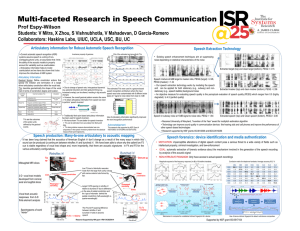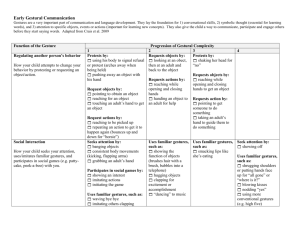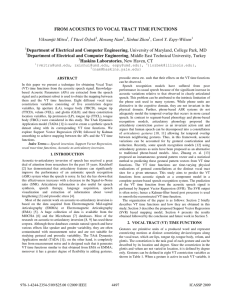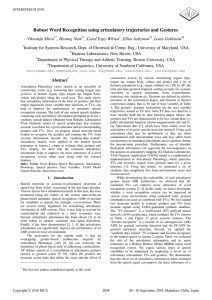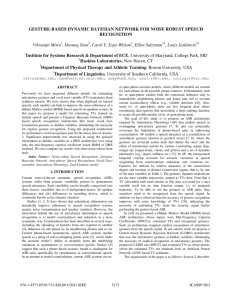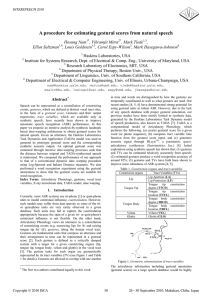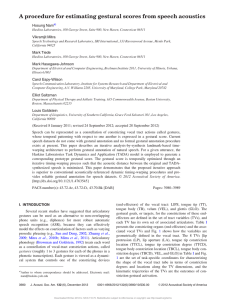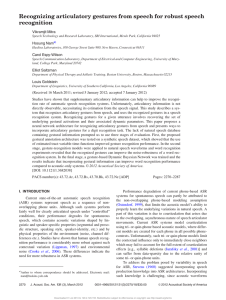From Acoustics to Vocal-Tract time Functions
advertisement
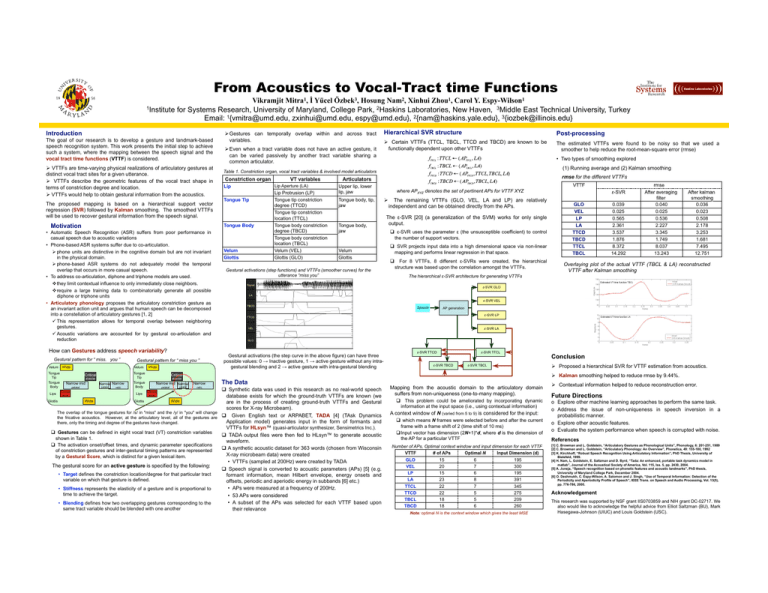
From Acoustics to Vocal-Tract time Functions
1Institute
Vikramjit Mitra1, İ Yücel Özbek3, Hosung Nam2, Xinhui Zhou1, Carol Y. Espy-Wilson1
for Systems Research, University of Maryland, College Park, 2Haskins Laboratories, New Haven, 3Middle East Technical University, Turkey
Email: 1{vmitra@umd.edu, zxinhui@umd.edu, espy@umd.edu}, 2{nam@haskins.yale.edu}, 3{iozbek@illinois.edu}
Introduction
The goal of our research is to develop a gesture and landmark-based
speech recognition system. This work presents the initial step to achieve
such a system, where the mapping between the speech signal and the
vocal tract time functions (VTTF) is considered.
VTTFs are time-varying physical realizations of articulatory gestures at
distinct vocal tract sites for a given utterance.
VTTFs describe the geometric features of the vocal tract shape in
terms of constriction degree and location.
VTTFs would help to obtain gestural information from the acoustics.
The proposed mapping is based on a hierarchical support vector
regression (SVR) followed by Kalman smoothing. The smoothed VTTFs
will be used to recover gestural information from the speech signal.
Motivation
How can Gestures address speech variability?
Gestural pattern for “ miss. you ”
Wide
Tongue
Body
Gestural pattern for “ miss you ”
Velum
Tongue
Tip
alveolar
Narrow mid
Wide
Tongue
Tip
Critical
palatal
Even when a tract variable does not have an active gesture, it
can be varied passively by another tract variable sharing a
common articulator.
Narrow Narrow
palatal
velic
Close
labial
The estimated VTTFs were found to be noisy so that we used a
smoother to help reduce the root-mean-square error (rmse)
• Two types of smoothing explored
(1) Running average and (2) Kalman smoothing
Lip Aperture (LA)
Lip
Tongue Tip
Velum
Glottis
Lip Protrusion (LP)
Tongue tip constriction
degree (TTCD)
Tongue tip constriction
location (TTCL)
Tongue body constriction
degree (TBCD)
Tongue body constriction
location (TBCL)
Velum (VEL)
Glottis (GLO)
Upper lip, lower
lip, jaw
Tongue body, tip,
jaw
Tongue body,
jaw
Velum
Glottis
Gestural activations (step functions) and VTTFs (smoother curves) for the
utterance “miss you”
where APXYZ denotes the set of pertinent APs for VTTF XYZ
The remaining VTTFs (GLO, VEL, LA and LP) are relatively
independent and can be obtained directly from the APs.
The ε-SVR [20] (a generalization of the SVM) works for only single
output.
ε-SVR uses the parameter ε (the unsusceptible coefficient) to control
the number of support vectors.
SVR projects input data into a high dimensional space via non-linear
mapping and performs linear regression in that space.
For 8 VTTFs, 8 different ε-SVRs were created, the hierarchical
structure was based upon the correlation amongst the VTTFs.
palatal
palatal
Close
labial
0.039
0.025
0.565
2.361
3.537
1.876
8.372
14.292
0.040
0.025
0.536
2.227
3.345
1.749
8.037
13.243
0.036
0.023
0.508
2.178
3.253
1.681
7.495
12.751
Overlaying plot of the actual VTTF (TBCL & LA) reconstructed
VTTF after Kalman smoothing
Signal
ε-SVR GLO
LA
ε-SVR VEL
TBCD
Speech
AP generation
ε-SVR LP
TTCD
ε-SVR LA
VEL
GLO
ε-SVR TTCD
Gestural activations (the step curve in the above figure) can have three
possible values: 0 → Inactive gesture, 1 → active gesture without any intragestural blending and 2 → active gesture with intra-gestural blending
ε-SVR TTCL
ε-SVR TBCD
Conclusion
Proposed a hierarchical SVR for VTTF estimation from acoustics.
ε-SVR TBCL
Kalman smoothing helped to reduce rmse by 9.44%.
alveolar
Narrow mid Narrow
GLO
VEL
LP
LA
TTCD
TBCD
TTCL
TBCL
The hierarchical ε-SVR architecture for generating VTTFs
Critical
Tongue
Body
Lips
Post-processing
Certain VTTFs (TTCL, TBCL, TTCD and TBCD) are known to be
functionally dependent upon other VTTFs
rmse for the different VTTFs
Narrow
velic
The Data
Synthetic data was used in this research as no real-world speech
database exists for which the ground-truth VTTFs are known (we
Glottis
Glottis
Wide
Wide
are in the process of creating ground-truth VTTFs and Gestural
scores for X-ray Microbeam).
The overlap of the tongue gestures for /s/ in "miss" and the /y/ in "you" will change
Given English text or ARPABET, TADA [4] (TAsk Dynamics
the fricative acoustics. However, at the articulatory level, all of the gestures are
Application model) generates input in the form of formants and
there, only the timing and degree of the gestures have changed.
VTTFs for HLsyn™ (quasi-articulator synthesizer, Sensimetrics Inc.).
Gestures can be defined in eight vocal tract (VT) constriction variables
TADA output files were then fed to HLsyn™ to generate acoustic
shown in Table 1.
waveform.
The activation onset/offset times, and dynamic parameter specifications
A synthetic acoustic dataset for 363 words (chosen from Wisconsin
of constriction gestures and inter-gestural timing patterns are represented
X-ray microbeam data) were created
by a Gestural Score, which is distinct for a given lexical item.
• VTTFs (sampled at 200Hz) were created by TADA
The gestural score for an active gesture is specified by the following:
Speech signal is converted to acoustic parameters (APs) [5] (e.g.
• Target defines the constriction location/degree for that particular tract
formant information, mean Hilbert envelope, energy onsets and
variable on which that gesture is defined.
offsets, periodic and aperiodic energy in subbands [6] etc.)
• APs were measured at a frequency of 200Hz.
• Stiffness represents the elasticity of a gesture and is proportional to
time to achieve the target.
• 53 APs were considered
• A subset of the APs was selected for each VTTF based upon
• Blending defines how two overlapping gestures corresponding to the
same tract variable should be blended with one another
their relevance
Lips
Hierarchical SVR structure
Table 1. Constriction organ, vocal tract variables & involved model articulators
Tongue Body
• Automatic Speech Recognition (ASR) suffers from poor performance in
casual speech due to acoustic variations
• Phone-based ASR systems suffer due to co-articulation.
phone units are distinctive in the cognitive domain but are not invariant
in the physical domain.
phone-based ASR systems do not adequately model the temporal
overlap that occurs in more casual speech.
• To address co-articulation, diphone and triphone models are used.
they limit contextual influence to only immediately close neighbors.
require a large training data to combinatorially generate all possible
diphone or triphone units
• Articulatory phonology proposes the articulatory constriction gesture as
an invariant action unit and argues that human speech can be decomposed
into a constellation of articulatory gestures [1, 2]
This representation allows for temporal overlap between neighboring
gestures.
Acoustic variations are accounted for by gestural co-articulation and
reduction
Velum
Gestures can temporally overlap within and across tract
variables.
Mapping from the acoustic domain to the articulatory domain
suffers from non-uniqueness (one-to-many mapping).
This problem could be ameliorated by incorporating dynamic
information at the input space (i.e., using contextual information)
A context window of N (varied from 5 to 9) is considered for the input:
which means N frames were selected before and after the current
frame with a frame shift of 2 (time shift of 10 ms)
Input vector has dimension (2N+1)*d, where d is the dimension of
the AP for a particular VTTF
Number of APs, Optimal context window and input dimension for each VTTF
GLO
VEL
LP
LA
TTCL
TTCD
TBCL
TBCD
15
20
15
23
22
22
18
18
6
7
6
8
7
5
5
6
195
300
195
391
345
275
209
260
Note: optimal N is the context window which gives the least MSE
Contextual information helped to reduce reconstruction error.
Future Directions
o Explore other machine learning approaches to perform the same task.
o Address the issue of non-uniqueness in speech inversion in a
probabilistic manner.
o Explore other acoustic features.
o Evaluate the system performance when speech is corrupted with noise.
References
[1] C. Browman and L. Goldstein, “Articulatory Gestures as Phonological Units”, Phonology, 6: 201-251, 1989
[2] C. Browman and L. Goldstein, “Articulatory Phonology: An Overview”, Phonetica, 49: 155-180, 1992
[3] K. Kirchhoff, “Robust Speech Recognition Using Articulatory Information”, PhD Thesis, University of
Bielefeld, 1999.
[4] H. Nam, L. Goldstein, E. Saltzman and D. Byrd, “Tada: An enhanced, portable task dynamics model in
matlab”, Journal of the Acoustical Society of America, Vol. 115, Iss. 5, pp. 2430, 2004.
[5] A. Juneja, “Speech recognition based on phonetic features and acoustic landmarks”, PhD thesis,
University of Maryland College Park, December 2004.
[6] O. Deshmukh, C. Espy-Wilson, A. Salomon and J. Singh, “Use of Temporal Information: Detection of the
Periodicity and Aperiodicity Profile of Speech”, IEEE Trans. on Speech and Audio Processing, Vol. 13(5),
pp. 776-786, 2005.
Acknowledgement
This research was supported by NSF grant IIS0703859 and NIH grant DC-02717. We
also would like to acknowledge the helpful advice from Elliot Saltzman (BU), Mark
Hasegawa-Johnson (UIUC) and Louis Goldstein (USC).
